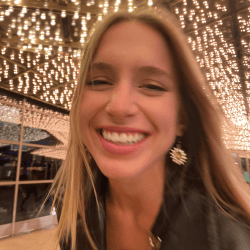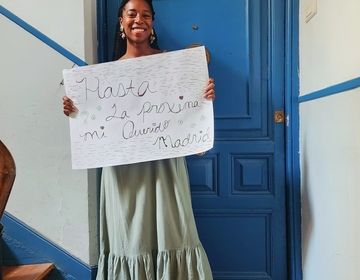A Sense of Control When Things Are Out of Control
And finally, after months of organizing paperwork, scouring apartment websites, prepping school materials, and saying bittersweet “see you laters” back home, I’ve made it! Once again, I am calling this beautiful city of Madrid my home.
I’ve been settled in my apartment, my “piso”, for about a week now, and I want to share with you all how I managed to tackle the logistics of getting here and finding my footing despite the chaos that comes with moving to a new country. This type of drastic change is part of being a CIEE language assistant, but it brings implicit instability as we wait upon federal approval of our visas, hunt for houses in untraveled neighborhoods, and attempt to prepare ourselves for the unknown teaching responsibilities. If you’re anything like me, who always loves to have a detailed plan and is addicted to making to-do lists, the key to surviving this process where everything seems out-of-control is PROACTIVITY.
GETTING YOUR VISA
Without a doubt, the most complex, yet vital, aspect of coming to live in Spain is attaining a visa. The comforting part of this is that CIEE provides both a visa application timeline and a visa document checklist organized by the consulate location. These are LIFESAVERS.
My visa experience was unique because I used the Los Angeles consulate, which, because of its central location, took a lot more time to process its applicants than others, especially with COVID restrictions in place. Knowing this, I was able to use the provided visa guide to plan ahead. The timeline that CIEE gives has a range of dates laying out when to do a task. For example, to arrive in late September, I needed to do my background check between May 6th and May 20th, and my doctor’s appointment for health clearance needed to be between June 20th and July 15th. I made sure that my appointments were scheduled within the first few days of each suggested range so that I could account for the 6-8 weeks it takes to get an Apostille to certify the background check, and, also, the indeterminate time it takes for a certified translator to go through each document. I was lucky because my consulate accepted digital translations, so I was able to simply print the signed copies, which were ready after two days. Before snail-mailing my thick, fateful application packet, I went one-by-one through CIEE’s Los Angeles document checklist and cross-referenced it with the consulate’s website. Then, I organized everything into piles of original documents, copies to go along with the application, and extra copies to take with me to Spain. This planning ended up being very convenient because many documents used in the visa application are also used by the police here when you apply for your residency card (TIE) and by your school on the first day.
Overall, the key to a successful visa process was staying on top of deadlines, double-checking my paperwork, and keeping a safety net of copies. This allowed me to mail in my documents as early as possible, knowing I could wait anywhere from 7-9 weeks rather than the standard 5-6 that less popular consulates advertise. In the end, it took about 9 weeks, but I avoided major stress because I gave myself a comfortable window to wait.
APARTMENT HUNTING
Now, after turning in my visa application with crossed fingers, the next looming question was “where am I going to live?” I found that my apartment hunting only came to fruition after physically being in Spain, but the process of moving after agreeing to a lease went much faster here than in the United States. In other words, DO NOT WORRY, you will find a home even if you only have a few days to search in person! I arrived on a Sunday and had a place by Wednesday, but again, what led me to finding my piso in such a short time was being proactive.
Before leaving California, I had the advantage of living in Madrid during my study abroad, so I knew the very general “personalities” of the different neighborhoods. However, I wanted to live in a completely different area than my previous stay in order to make the most out of my experience, so I did a lot of research about what there is to do in each area, as well as watched apartment tours on YouTube. From there, I explored rentals on the platforms Idealista, Badi, and Fotocasa (with my location, pricing, and amenities filters on) and messaged landlords about my interest, their pricing, and if utilities (gastos) were included. Because of the 9 hour time difference between here and CA, I had to send online messages rather than call. Unfortunately, I quickly realized that in order to get a sufficient response, I had to put all of my questions in one initial message and translate it into Spanish. Even so, many landlords took a very long time to respond, and by the time they did, their space wasn’t available anymore. I found much more success calling the listed numbers on the sites to ask my questions after I arrived in Spain, which worked out because most landlords wanted to meet in person before agreeing to a lease anyways.
Though this is a tedious process, it is very useful for finding a place you love! I strongly suggest that you DO NOT SIGN A LEASE until you get the opportunity to see the space and make sure it is in good condition, as well as walk around the neighborhood to make sure you feel comfortable there. Be prepared to compromise on your ideas for a space— such as bed size, windows, balconies, and furniture— and be realistic with your budget. After all, finding your living situation should be both practical for your lifestyle and induce excitement for your future here! With foreign bank accounts too, service fees can be tricky, especially when making your hefty piso deposits. I recommend using the third-party transfer app “WISE” to reduce the costs you eat in transferring money from your home account to your Spanish account. Overall, remember, even if it’s not picture-perfect, you can always make a space feel more like home with a few personal touches and some decor, but you will never be able to make up for lost travel opportunities because you’re stuck paying hundreds of euros extra for a more luxurious space!
Ultimately, planning ahead was super useful for me to reduce my stress and gain a sense of control over my fate. With both major steps of moving abroad— getting my visa and picking my apartment— being proactive allowed me to stay on top of my deadlines, find comfort even with bureaucratic hold-ups, and find a realistic place to live that I absolutely love!
Related Posts
TWICE with CIEE: Kayleigh in Spain (PART 2)
Kayleigh is a CIEE alum who participated in CIEE's Teach in South Korea program AND CIEE’s Teach in Spain Volunteer program! CLICK HERE to read her experience in Korea. WHY... keep reading
CIEE Volunteer Spotlight: Meet Layla!
Where are you from? What was your academic background or career before teaching abroad? I am Canadian, specifically Québécoise. In Quebec, students are required to attend community college (CEGEP) before... keep reading












